Double Eleven is not just a shopping festival; it's a massive digital celebration, with sales reaching an impressive $168.2 billion. It's the highlight of the year for Alibaba and a time of joy for consumers. However, for logistics workers, it's also one of the most demanding periods. Recently, JD.com's attention to its delivery staff has gained public praise. The company introduced exoskeleton robots to help reduce back injuries among workers, who often bend over and lift heavy items repeatedly. This is especially crucial during peak seasons when the strain on their bodies is at its highest.
A company’s success isn’t only measured by its financial performance but also by how well it treats its employees. JD.com’s initiative marks the first industrial application of exoskeleton technology in China, showcasing a new direction in workforce support.

*JD employees wearing exoskeleton robots*
**The origin of exoskeleton robots**
Exoskeletons have long captured the imagination, especially through movies like *Edge of Tomorrow*, where soldiers wear advanced suits to enhance their strength. In reality, the concept dates back to the 19th century. In 1830, British illustrator Robert Seymour sketched a steam-powered walking aid, which inspired future developments in exoskeleton technology.
In 1890, Russian inventor Nicholas Yagen created a compressed-air-powered exoskeleton system. By 1917, American engineers developed a steam-powered version. In the 1970s, General Electric introduced the Hardman system, capable of lifting 1,500 pounds. With advancements in electronics, sensors, and control systems, exoskeletons made significant progress in the late 20th century.
Companies like Raytheon developed systems such as XOS, which allowed users to lift hundreds of pounds with ease. These technologies were initially military-focused, but soon, they began to find applications in healthcare and industry.
**Exoskeleton development in China and abroad**
While China lags behind some countries in exoskeleton research, the development path follows a similar trajectory—starting from military use and moving toward commercial applications. In 2013, the Nanjing Military Region General Hospital unveiled the “Single Weight-Bearing Auxiliary System,†a military-grade exoskeleton designed to assist in carrying loads. Though considered one of the most complete systems in China, it still needs improvements in functionality and design.
In 2014, the Changzhou Institute of Advanced Chinese Academy of Sciences launched the EXOP-1, a lightweight exoskeleton equipped with 22 sensors and a controller. Despite its advantages, it remains bulky and not yet widely used.
In the commercial sector, companies like Daai, Scream Technology, and Fu Liye Intelligence have begun releasing products. Just recently, a new exoskeleton called BEAR H1 was launched, aimed at patients with hemiplegia.
**Industrial exoskeletons: A growing trend**
Although rehabilitation exoskeletons are more common today, the industrial sector is now catching up. Companies like Panasonic and Ekso Bionics are leading the way. Panasonic introduced an exoskeleton in 2014 that helps workers carry 15 kg loads with ease. Their latest models include AWN-03, PLN-01, and Power Loader, all designed to reduce physical strain.
Ekso Bionics, known for medical exoskeletons, has expanded into the industrial field with the EksoVest, currently being tested at Ford factories. Future expansion to Europe and Latin America is planned.
Despite challenges like weight and battery life, these exoskeletons represent a major step forward. JD.com’s exoskeleton, seen in recent videos, appears to be pneumatically powered, indicating early-stage development.
Experts believe that if breakthroughs occur in motors and batteries, the industrial exoskeleton market will see significant growth. As more companies invest in this technology, the future looks promising for both workers and industries alike.
Pet Braided Sleeve,Braided Wire Sleeving,Pet Cable Sleeving,Pet Expandable Sleeving
Shenzhen Huiyunhai Tech.Co., Ltd. , https://www.cablesleevefactory.com